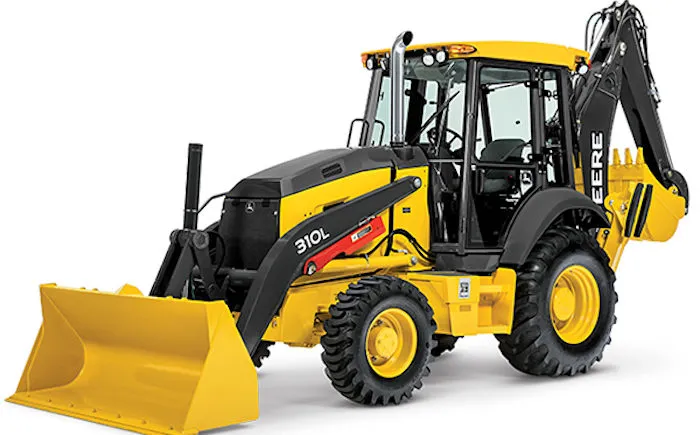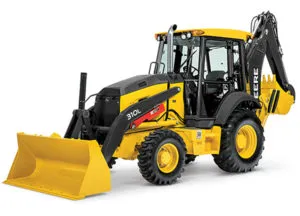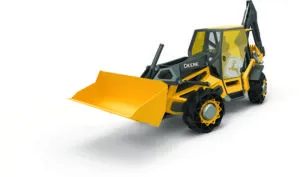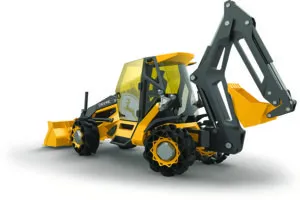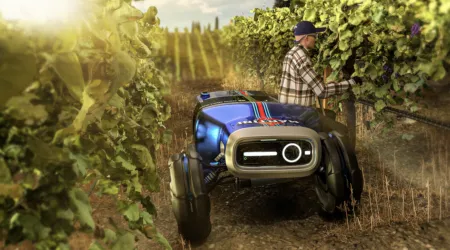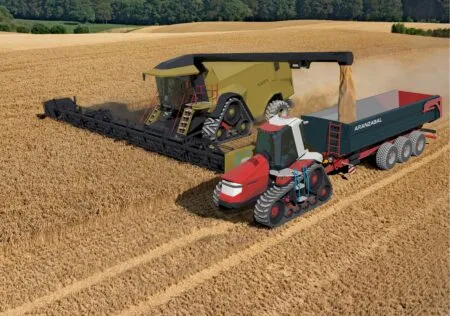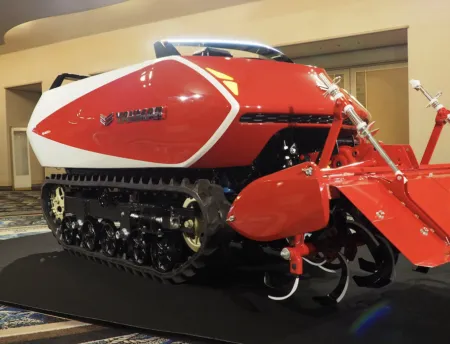What is the most commonly requested improvement John Deere customers want made to a backhoe loader? More power? Better fuel economy? Smarter controls? No, it’s much simpler – more comfort. But sometimes the simplest requests can be the hardest to achieve.
“Customers say, ‘I spend all day in these things. How can I be more comfortable?” confirms Robert Moore, global manager of product verification and validation for John Deere. “It’s a simple request, but it’s tough to do on a tractor. So we had to start with a clean slate.” And so the Fixstern backhoe concept was born – a vision of what a backhoe could look like in 10 years’ time.
Technical challenges
One reason it’s challenging to make a backhoe cab more comfortable is that it’s difficult to increase the space available to the operator on account of the large rear wheel housing, which cuts into the cabin. “The rear wheels define how long the door sill can be,” says Moore. “They intrude into the space for the operator and make it hard to turn the seat around. Operators want additional room and more comfort when they rotate from forward facing to rearward facing. They also want much better front and rear visibility. We’ve known for decades that we’d like to make these things better, but it’s a real challenge.”
That’s why John Deere decided to go back to the drawing board. “We asked ourselves, if we could do anything we want with a backhoe, what would we do? So we collaborated with BMW Designworks on the Fixstern Backhoe,” says Moore, who is an experienced backhoe engineer. “We want to get this vision out there and share some of the innovations with our customers to see which of the ideas we are presenting ring most truly with them. Then we’ll try to pull those forward and see if we can implement them sooner.”
Revolutionary design
Reducing the size of the rear wheels on the Fixstern while still maintaining stability was no easy feat. Ultimately it was another technical innovation – the hybrid electric powertrain – that had indirect effects that made this design viable. “The hybrid drive lowers the center of gravity,” explains Moore. “It decouples the drivetrain in such a way that we could push the wheelbase out and move the rear wheel further back. That enabled us to reconfigure some other things, giving the mainframe a modular nature. It opened up some spaces for storage and gives options for frames we might mount to the machine in the future.”
Another way in which John Deere has managed to increase cabin space is with a lightweight matrixed metal exoskeleton concept. This uses emerging materials to reconfigure the traditional backhoe form.
“The extra space could contain an auxiliary fuel tank,” says Moore.
“Or a hydraulic power unit to run hammers or saws or whatever else you might want.”
The Fixstern design was previewed at ConExpo in Las Vegas in March, with virtual reality headsets giving attendees the chance to experience what it would feel like to sit in the cab. Extra space in the cabin freed up by the new design enhances sight lines, as well as creating space for storage bins. “There are large storage pods that rotate with the seat,” says Moore. “The operator can rotate them and access them from the operator seat from the front or back position. There’s also shelving.” This feature was particularly popular with customers who experienced the simulations in Vegas.
Changing the wheel base brought with it an additional challenge in terms of where to locate stabilizers, because there was no longer room in the traditional position at the rear. Now they fold away on each side in front of the rear wheels.
“They still hit the ground in the same way as they do today. But they pivot from a completely different point,” says Moore. “The goal was to maintain the same footprint and the same stability, and we accomplished that just by moving the pivot.”
Intelligence and connectivity
Of course, as a machine of the future, the Fixstern is designed to harness the latest in artificial intelligence and connectivity, drawing from the most recent telematics ideas from John Deere. “Telematics today is becoming wi-fi,” says Moore. “In the past couple of months we released a wi-fi device that enables communication between machines and operators, and machines and bystanders. And you can get diagnostic information on your smart device about what might need attention at the next service.”
For the Fixstern this concept is taken a stage further with a heads-up display on a visor connected to a hard hat, which not only helps with machine servicing but also real-time operation. “It’s an augmented reality view that can ‘paint’ a track to show the operator the digging target depth as he changes view.”
Designing the Fixstern was a two-year project, but only the latest in what is now a 20-year relationship between John Deere and BMW Designworks. It is a relationship of which Moore is proud: “As our models have progressed, they have started to abide by a more stringent industrial design language, which is a major achievement.”
Now all that remains to be seen is how many Fixstern features are incorporated into market-ready machines by the time the June 2027 issue of iVT is published. We’ll do our best to remember to take a look back and inform you.
CONTACT DETAILS
Web: www.behance.net/albertoseco
Email: albsec@euskatel.net


